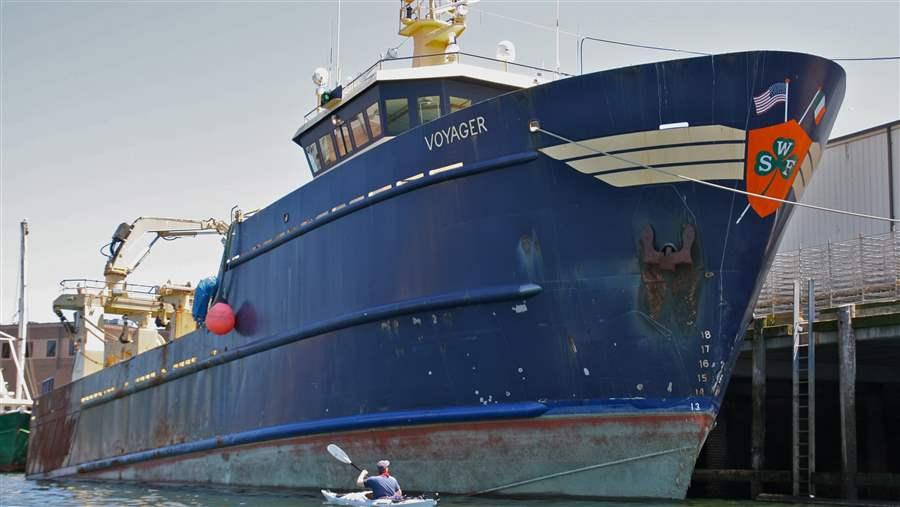Atlantic Herring on Fishery Managers’ Agenda
Coming soon: A chance to protect one of New England’s most important forage fish

Herring trawlers are among the largest fishing vessels on the East Coast, dwarfing recreational and small commercial vessels.
The Pew Charitable TrustsIn the coming months, the New England Fishery Management Council will make big decisions about Atlantic herring—a key source of food for many of the region’s popular marine species, including cod, striped bass, puffins, bluefin tuna, and humpback whales—and your voice will be essential to ensuring that the council makes the best choices for the health of our wildlife and coastal communities.
Fishing for herring in the North Atlantic involves industrial-scale ships pulling football field-sized nets through the water. With enough space to store a million pounds of fish, these trawlers, which sell their haul primarily to lobster fishermen for use as bait, loom over the small fishing boats that most Americans associate with Cape Cod or Down East Maine.
When herring trawlers are allowed to operate close to shore, they pose a threat to wildlife and commercially important fish. Many species—from tuna and striped bass hunting for a meal to river herring schooling with their Atlantic cousins before swimming up the rivers to spawn—are accidentally captured in the massive nets, sometimes by the thousands. The impact on these fish populations can be significant.
And as the vessels sweep through and take tons of herring from coastal waters, they force predators, such as birds, fish, and marine mammals, to travel miles in search of food. This exodus disrupts other fishermen who target those species. That’s why commercial cod and tuna fishermen, recreational striped bass fishermen, whale watch operators, and conservationists have long agreed that allowing industrial scale herring trawling in these areas is shortsighted and irresponsible.
The solution is to move the industrial herring trawl fleet farther out to sea, where it will not disturb the fragile nearshore ecosystem, and to follow science-based catch limits to ensure that it doesn’t take too many Atlantic herring. This common-sense approach is already in place elsewhere in the Gulf of Maine during the summer months and in Massachusetts’ coastal areas.
Managers can also set fairer, more scientifically appropriate catch limits by adopting a “control rule,” which relies on a formula to adjust the amount of herring that can be caught as the population changes over time. This would help mitigate short-term political and economic pressures while balancing the survival needs of ocean wildlife with the industrial herring fleet’s desire to maximize its catch.
Improved management would benefit New England’s traditional coastal economies. When nearshore commercial fishermen can catch the high-value species they target, and wildlife can find enough to eat where they live, the fabric of our vibrant shoreline is strengthened.
Managers already have all the scientific information they need to make sound, well-informed choices. But they will also need to hear a strong call from the public for a smart, common-sense approach to Atlantic herring. Watch this space for your chance to tell New England’s ocean fishing managers that you value a healthy ocean ecosystem and strong coastal communities.
Peter Baker directs ocean conservation efforts in the Northeast for The Pew Charitable Trusts.


This video is hosted by YouTube. In order to view it, you must consent to the use of “Marketing Cookies” by updating your preferences in the Cookie Settings link below. View on YouTube
This video is hosted by YouTube. In order to view it, you must consent to the use of “Marketing Cookies” by updating your preferences in the Cookie Settings link below. View on YouTube







